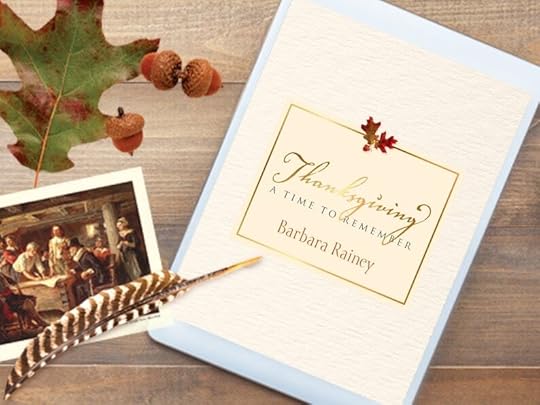Barbara Rainey's Blog, page 5
January 22, 2024
The Messiah Mystery: A Quest to Follow Clues to One of the Greatest Mysteries Ever
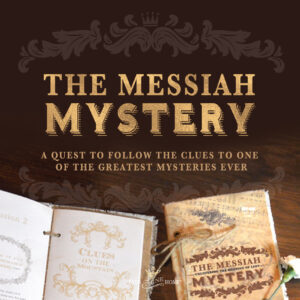
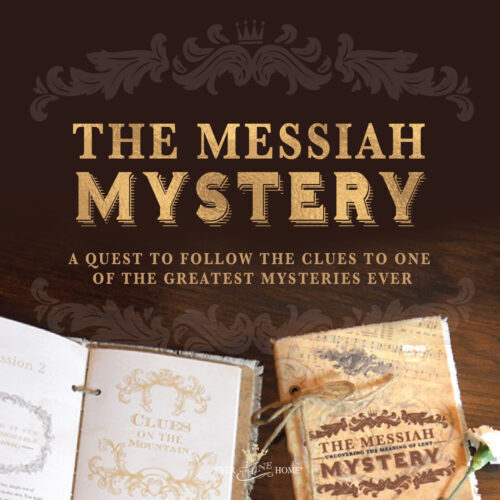
Have you ever tried to solve a mystery? Or have you read a detective novel or two where you have no idea now it will end?
Some of the most fascinating detective stories are full of twists and turns that leave you surprised and hungry for more. Did you know that God’s story in the Bible is actually a series of clues? It’s true! And the clues in the Old Testament reveal one of the most mind-boggling mysteries of all time—the Messiah who would come one day to live on the earth and pay the ultimate price for our sin.
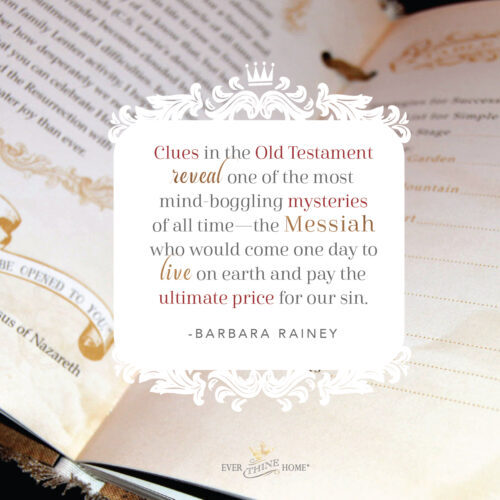
You see, with God nothing is random. Every detail is ordered with purpose. So His clues about the Messiah aren’t haphazard or left behind accidentally. They are purposeful and perfectly orchestrated.
As parents we long to influence our children toward truth, to connect with them in meaningful ways. When we teach them about Jesus we are taking our children’s hands and helping them touch the transcendent unseen. Bringing the reality of the eternal to our homes knits relationships together.
But how do we take our children there? Sometimes that feels like the biggest mystery of all.
Reading Bible stories is good. Praying with your children is also good. But so many of us long for interactive opportunities, too.
I remember well how busy I was as a mom of six. It was a challenge to create meaningful moments with my children. But we parents must find a way to do this, especially as we enter Lent season!
So I want to help you with six easy, practical little moments to love your family through Easter. Grab a magnifying glass and put on your sleuth jacket. A mystery going back thousands of years awaits!
We’ve created a six-part series called “Messiah Mystery.” Six weekly lessons, beginning on Ash Wednesday, will lead you and your family through Scripture, hot on the trail to discovering the true meaning of Lent and unearth the joy of Easter’s miraculous resurrection. Children of all ages can become detectives, unearthing clues that lead to the greatest mystery of all.
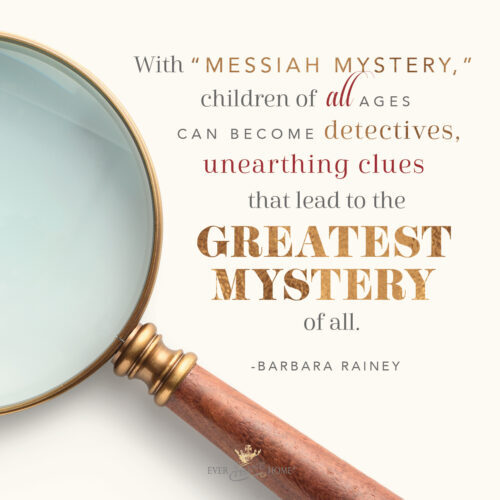
Here’s an excerpt from the first lesson of Messiah Mystery.
Clues in the Garden
Are you ready to uncover the first clues to the Messiah Mystery? You’ll need to use your imagination. Put yourself in the story, walk around with the characters, let no detail escape you.
The experience of Adam and Eve in the Garden of Eden must have been nothing short of spectacular. But far better than any smell or taste or sight was being in the presence of God, their creator. You see, one of the reasons God created Adam and Eve was to have a friendship with them. He tells us He made them in His image, like God.
This friendship with God is only true for mankind. God didn’t have a friend relationship with the animals, only with Adam and Eve. This is how life was meant to be. The garden was perfect because He was there. His presence and nearness is what made it good.
But Adam and Eve disobeyed. They believed the lie of the serpent, that God was withholding something good from them, that God didn’t love them. Have you ever believed this lie? Yes, you have. I have. We all have. And that is what sin looks like in our world: believing that God doesn’t love us, that we know better, that we would choose better for our lives than our loving Heavenly Father.
Because God is both perfect love and perfect justice, He must correct His children’s disobedience. And like any honorable king, God must also respond to evil. His discipline to Adam and Eve is the gift of pain so that they won’t forget what they did wrong.
At the same time, He shows His deep love by giving them a promise. Genesis 3:15 prophesies, “I will put enmity between you and the woman, and between your offspring and her offspring; he shall bruise your head, and you shall bruise his heel.”
This is God’s very first clue. “He shall bruise your head” means the Messiah will someday defeat Satan and win His children back! Believe it or not—in the very moment when paradise has been lost—God offers you and me comfort, hope, and a promise of Jesus.
As you ready your heart for Easter, thank God for how loving He is. In the midst of the very first sin, the very first time that people didn’t trust Him and His character—He was already planning to die so that we could be with Him again. He was already planning His merciful rescue of a hurting world.
That is Love.
Father, Thank You that you were not caught off guard by Adam and Eve’s disobedience. You had a plan in place from the very beginning, before the world even began. Because you loved them and you love us You prepared a way for us to come back to You, to know You, and to live with You forever. We stand in awe of You.
This is adapted from lesson one in the six-part Messiah Mystery series. You can order the entire package from our Etsy store.
This interactive curriculum is a great experience to teach your family about the long wait for the Messiah to come. Your kids will love the hands-on activities too.
May God bless you as you seek and find clues to the Messiah Mystery during the season of Lent.
Join us in becoming #Easterpeople …
For whom the cross is everything!
The post The Messiah Mystery: A Quest to Follow Clues to One of the Greatest Mysteries Ever appeared first on Ever Thine Home.
January 15, 2024
Observing Lent: A Season of Waiting and Worship
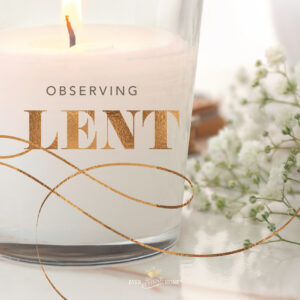
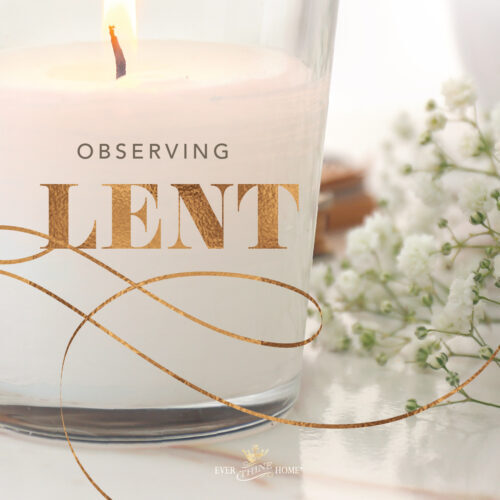
Is waiting something you enjoy and eagerly look forward to?
Not me!
When I think of waiting, I think of sitting in a doctor’s office waiting room. Or sitting in my car on the freeway, with traffic stopped dead and no exit nearby. Or standing in line at the department of motor vehicles for what seems like hours.
Waiting is not my favorite way to spend my time, but waiting does remind me I’m not in control. God’s ways are higher than mine, He knows circumstances I can’t see, and He even allows waiting for me and you to teach us patience for reasons we’ll never know.
But then there is a good kind of waiting that most of us enjoy, like waiting for Christmas, or the anticipation of a birthday or a wedding or a surprise of some type. This makes the moment much more significant.
Observing Lent, which starts next month with Ash Wednesday on February 14, is a way to anticipate Easter in much the same way we anticipate Christmas. Lent is to Easter what Advent is to Christmas; it’s a time to prepare and anticipate. Like Advent, Lent is also a great opportunity to lead your family in some kind of Bible study or for discipling you kids at home.
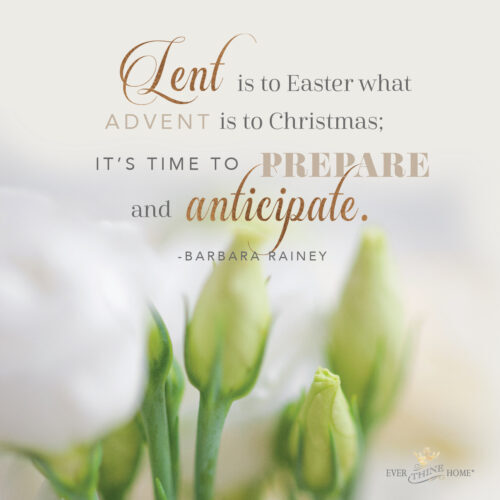
You may know a little about Lent—that it can involve “fasting,” that the Catholic community generally emphasizes it more than Protestants. But in recent years more and more Protestant churches have begun to incorporate Lent into their church calendar to help their members learn from the historic observance and to prepare to celebrate Easter. Personally, I’ve been observing Lent as a way to prepare for Easter for the last 10 years and it’s become a very meaningful season to help me prepare for the most important holiday of the year.
What is Lent?
Lent was established centuries ago by church leaders to help Christ followers remember the humility of Jesus and imitate Him as we are called to do. The word Lent means “the lengthening of days,” which refers to the steadily increasing time of sunlight we experience during Spring. The observance began during the apex of the Roman Empire in the infant years of the church.
The 40-day period between Ash Wednesday and Easter Sunday became infused with biblical meaning. It mirrors the 40 days Jesus spent fasting in the wilderness, the 40 days and nights of rain during the flood, the 40 days Moses spent on Mount Sinai, and the 40 days Jesus walked the earth between His resurrection and His ascension.
Lent officially begins with simple somber church services on Ash Wednesday. Its purpose is to call us to repentance, and it’s marked by the application of ashes to the foreheads of worshippers who choose to come forward.
Ashes indicate mourning throughout the Old Testament. 2 Samuel 13:19 tells us, “Tamar put ashes on her head and tore the long robe she wore.” Esther 4:1 says, “Mordecai put on sackcloth and ashes and cried with a loud bitter cry.” Many others did the same, including Jeremiah, Ezekiel, Daniel, and Jonah.
This practice is an important reminder of our sin that separates us from God. It also reminds us that we are frail and finite. Genesis 18:27 tells us, “I am but dust and ashes” and Ecclesiastes 3:20 says, “All are from the dust and to dust all return.” We continually need to confess our pride before God Almighty, remember we are but dust, and pray earnestly for revival and for His restoration work.
Ideas for observing Lent
Here are four actions you can plan for the beginning of the Lenten season.
Attend a service at your church or another church on Ash Wednesday. It’s a very small sacrifice of time for such an important act of worship.Take your children if they are still living at home. And follow the practice of having ashes applied to your forehead in the shape of a cross.
If you want to continue the experience of Lent beyond Ash Wednesday, consider fasting.Removing things from our daily routines can also help us remember our need for the divine. Fasting doesn’t have to be from food; consider fasting from complaining or from worry. Reduce or eliminate screens—stop watching television or using social media for the 40 days of Lent. John Piper calls fasting the “pleasant pain” of self-denial. Make prayer a focus of your life for the next six weeks.Pray during Lent that we—as the body of Christ and as individuals—might bow before the Almighty in recognition of who we are in light of who He is. We will stand before Him one day all on our own not as part of a church or group. How will that feel? Will we, will you feel confident that you belong to Jesus and that you are His forever?We. Need. God. And prayer helps us remember we have nothing to offer apart from Jesus.
Here is a simple idea for adding more prayer to your daily life for six weeks: Set a timer on your watch or phone or in your kitchen to remind you to pray during the day. I suggest starting with three daily times of prayer: morning, noon and night. If you don’t know what to pray, there are lots of Lenten devotions you can follow and I bet your church has one or can recommend one.
Your prayers can be very simple. You can pray each time, with humility and focus, “Thank You, God, that You are with me. Thank You, Jesus, that You died for me.” Even a simple repeated prayer like this will please God and I’m confident will change your heart over six weeks. It’s not the words or length of time. It’s the attitude of remembering Him and bowing before Him in surrender that pleases Him.
Go through the “Messiah Mystery” series of devotions with your children.This series offers six weekly lessons, beginning on Ash Wednesday, to lead you and your family on a quest to discover the true meaning of Lent and unearth the joy of Easter’s miraculous resurrection. Each lesson offers clues for a mystery that goes back thousands of years—how God’s Word pointed to a future Messiah. Order it here.
Waiting is good for me. It is good for all of us. Savor the days before Easter this year and learn to use them for your family’s good. Use the season of Lent to increase your hunger for Him rather than indulging yourself with a thousand lesser things.
Take time for Jesus because He entered time for you.

Structure your life to make room for Him because He came to room with you.
Maranatha!
The post Observing Lent: A Season of Waiting and Worship appeared first on Ever Thine Home.
January 8, 2024
‘Spoonful of Sugar’: Bite-sized Morsels of God’s Word

We know you are busy! And we also know how easy it is to neglect God’s Word when life is moving so fast.
If you ever need a reminder of why God’s Word is so important for all of us, read Psalm 119. It’s full of wonderful descriptions like “Your word is a lamp to my feet and a light to my path” (verse 105) and “Your testimonies are my heritage forever, for they are the joy of my heart” (verse 111).
Another favorite is “How sweet are your words to my taste, sweeter than honey to my mouth!” (verse 103). God’s Word isn’t just good for us like medicine, which often tastes bitter. It’s good for us like a tasty treat because the results of following God are pleasant and satisfying.
With this truth in mind, this year we are presenting a series of short devotions called “Spoonful of Sugar.” Scattered through the year a week at a time, we will send you a sweet bite of biblical truth to encourage you and help you grow closer to our Lord. These will be sent to our paid Substack subscribers, but this first one is free!
Spoonful of Sugar devotions will include one Bible verse and a few short questions to spark conversation around the verse’s meaning and message. We also offer a beautifully designed quote from each devotion as a free download so that you can pin it up on the fridge or set it in the center of your nightly dinner table.
If you’d like to receive these delectable, bite-sized morsels of God’s Word sprinkled throughout the year, we encourage you to join my Friends & Family. For only $5 a month you will receive all of my posts—not only the weekly blog posts you already receive but also my “Friends & Family” newsletters, special posts on “What I’m Reading” and “What I’m Learning,” our new podcast series Growing Older Not Old, and, of course, this new mini-devo “Spoonful of Sugar.” You’ll also have full access to anything I’ve written in the past. Sign up here.

Here’s the first “Spoonful of Sugar.” Hope you enjoy it!
Spoonful of Sugar: The Beauty of God

“He spreads the snow like wool and scatters the frost like ashes.”
Psalm 147:16
Each winter here in Central Arkansas, we never know if we will receive any snowfall. So February of 2021 was an unforgettable month—over 10 days Dennis and I experienced a sleet storm followed two days later by a major snowfall followed by another significant snowstorm. We ended up with nearly 18 inches of fluffy whiteness on the ground and layered on pine boughs and branches!
It was gorgeous! Having grown up just south of Lake Michigan in Crown Point, Indiana, snow was a regular part of my childhood and I have never lost my affection for winter’s beauty. Dennis and I love living in Arkansas, which is full of unspoiled natural beauty, but we do miss annual snowfalls. So three back-to-back winter storms was historic, and for us personally it was a wonderful gift.
I was entranced with the miraculous wonder of water becoming tiny ice crystals. It is true no two snowflakes are alike, and we watched as millions of these intricate and delicate beauties floated, spiraled, and danced their way to earth.
We went for many walks in our frozen sparkling cathedral. I wanted to feel the snow, hear the gentle crunch under my boots, watch the transformation of everything it touched.
And I saw. The small rises and falls in the shape of the earth that can’t be seen when all is brown. Little birds quietly flitting and hopping on pillows of white. They let us get closer to them in the silence as if we were experiencing wonder together.
At such times I am overwhelmed by the beauty of God’s creation. It’s easy to get caught up in the busyness of life and forget to notice the intricate, elegant beauties in God’s creation all around us.
Here are some questions to ponder, or discuss with your family:
Like seasonal foods, what are your favorite sights or sounds or smells of winter that are available only where you live?The apostle Paul wrote in Romans 1:20 that “For His invisible attributes, namely, His eternal power and divine nature, have been clearly perceived, ever since the creation of the world, in the things that have been made …” If you can take a few minutes, think about what you can “clearly perceive” about God in His creation.Find a book or webpage about snowflakes and read about their amazing designs and unique, one-of-a-kind shapes. Give thanks to God for His amazing creation!And then to consider that God created me as a unique human being … As Ephesians 2:10 says, “For we are God’s handiwork, created in Christ Jesus to do good works…” God is truly a wondrous Creator!
Use this FREE DOWNLOAD as a daily reminder with your family … put it up on your refrigerator!
Spoonful Printable – Psalm 147:16Remember: To receive Barbara’s complete “Spoonful of Sugar” series, become a paid Substack subscriber!
The post ‘Spoonful of Sugar’: Bite-sized Morsels of God’s Word appeared first on Ever Thine Home.
December 18, 2023
Cradle to Cross
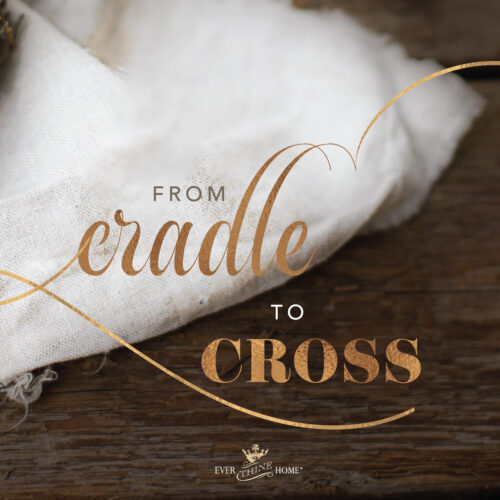
Beautiful Savior,
What more could be done than Thou has done!
Thy death is my LIFE,
Thy resurrection my PEACE,
Thy ascension my HOPE,
Thy prayers my COMFORT.
Help me give thanks today and forever. Amen.
A Puritan prayer quoted in Valley of Vision, compiled by Arthur Bennett
The incarnation of Jesus … His first coming to earth … incognito … as a tiny baby … is the focus of our month-long Christmas celebrations.
Or is it?
Christmas has become a feel-good, everyone-be-happy season. Even those far from God join in the festivities because it’s easy to ignore the Christian origins. The celebration of Christ’s birth has gotten lost in a swirl of fairy tales and merchandising.
Think about it. The stunning miracle of God becoming human has become trivialized with toys, tinsel, and shopping trips. We’ve made Christmas a season of unachievable expectations. Disappointment on Christmas morning is inevitable and universal.
Our focus has been misplaced.
The prayer above re-centers us on the work Jesus came to accomplish. Without these holy supernatural acts—His death, resurrection, ascension, and now His prayers for us—we would be eternally lost with nothing to celebrate.
Let that truth sink in for a moment.
Yes, we celebrate at Easter the death, resurrection, and ascension of Jesus Christ, but as we are fully immersed in Christmas tidings it is good to remember that Jesus was born in a manger only to die on a cross. The two events are not distinct; they were fully united in Him as He walked the long journey from the throne of heaven to our earth and back to heaven again.
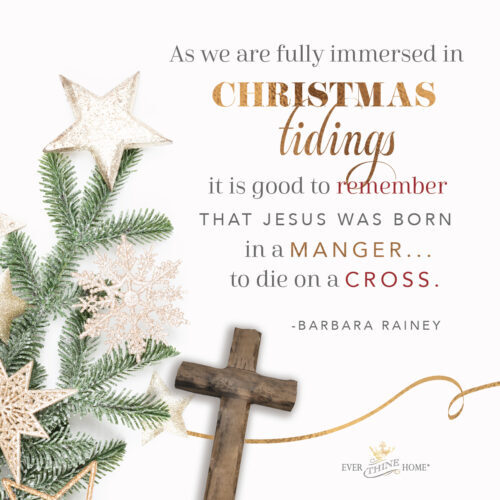
Today I invite you to slow your frantic pace and read this prayer slowly, out loud, and actually thank Jesus for what His birth gave us … eternal life because of the cross. Don’t let the enemy of your soul segregate these Easter miracles to a tiny space on your calendar next spring.
Christmas is a happy holiday while Easter’s story is squeamish, unsettling … a brutal, undeserved crucifixion. We’ve tidied it up with softer, gentler symbols like bunnies and baby chicks, but it is still about death.
Are you willing to remember the cross as you celebrate the cradle?
Will you remember all of His life as you celebrate His birth?
In addition to Christ’s birthday, will you remember His deathday, too? With deep heartfelt thanks and gratitude?
God loves YOU. He sent Jesus to be YOUR Savior. To rescue YOU. For without His death, resurrection and ascension, His miraculous incarnation for us on Christmas morning would mean nothing.
Let every heart prepare Him room, for He will return not as a helpless babe, but as a mighty, victorious King.
Maranatha!
Merry Christmas everyone!
The post Cradle to Cross appeared first on Ever Thine Home.
December 11, 2023
The Gift of Presence


The most meaningful gifts reveal profound knowledge: The giver knows the recipient well.
To be known … deeply, lavishly and individually, in spite of our flaws and weaknesses … and then to be loved anyway is the collective longing of humankind.
God knew that about us … and so, on the first Christmas morning, God gave us the gift of His presence.
Our Maker-Creator knows each one of us intimately—every cell, every intention, every thought, every word, every emotion, every experience. Out of that perfect and complete foreknowledge He gave us, at the right time, the best … gift … ever:
Jesus,
Immanuel,
God with us.
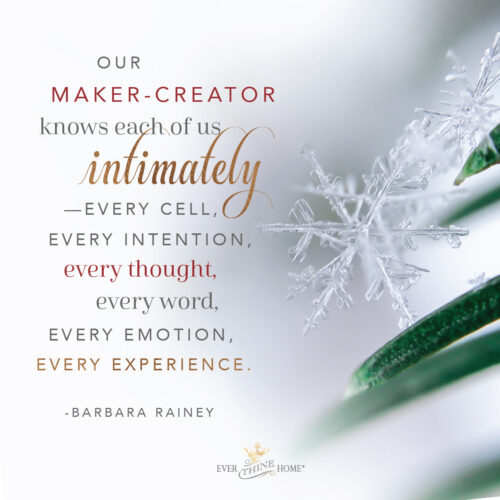
Oh, how we’ve misused and abused, neglected, and rejected this Gift. We know we are guilty.
But when we see the wonder of His with-ness … we want Him!
If you have received Him as the free gift of God, He is with you every day, in every place, in every circumstance, in every emotion, in every relationship. Nothing is beyond the reach of His presence.
St. Patrick penned a good summation of this truly awesome reality with these words:
“Christ with me,
Christ before me,
Christ behind me,
Christ in me,
Christ beneath me,
Christ above me,
Christ on my right,
Christ on my left,
Christ when I lie down,
Christ when I sit down,
Christ when I arise,
Christ in the heart of every man who thinks of me,
Christ in the mouth of everyone who speaks of me,
Christ in every eye that sees me,
Christ in every ear that hears me.”
And King David says it this way:
Where shall I go from your Spirit?
Or where shall I flee from your presence?
If I ascend to heaven, you are there!
If I make my bed in Sheol, you are there!
If I take the wings of the morning and dwell in the uttermost parts of the sea,
Even there your hand shall lead me,
And your right hand shall hold me.
(Psalm 139:7-11)
He is oh so much more than just our shadow.
He is within us, His Spirit residing inside us, dwelling in our being! That is the unspeakable wonder of God’s gift!
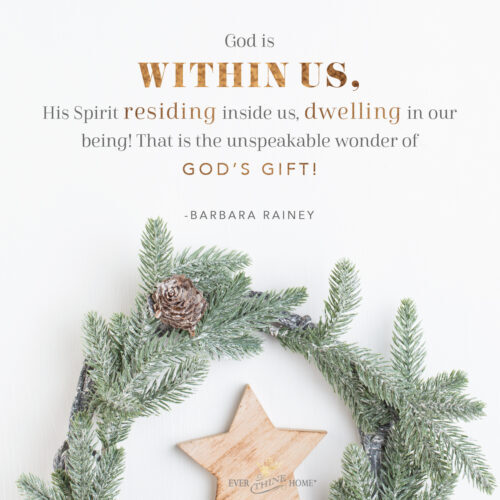
But wonders never cease …
WE ARE MADE IN HIS IMAGE, which means our presence matters too, more than we ever could possibly imagine.
God said it is not good for man to be alone. The word man has a double meaning which includes all mankind; it’s not good for any human—man, woman, or child—to be alone. Isolation is the opposite of with.
Isolation is the sharpest tool of pain the enemy uses. If Satan can convince us we are not loved, not wanted, not needed, he can convince us of any evil. And he has been doing that for centuries, as evidenced by repeated killings, suicides, and harms done daily to one another by multiplied millions.
Christmas came with the Gift of Jesus. We who are called by His name are to become like Him, so… this Christmas give your family the present of presence. Don’t let anyone in your home or near you become isolated!
Give your presence to be with one another. Your children and spouse and others need you, and you need them.
When our son came home with his four kids to visit us during their fall break, giving his wonderful wife a weekend off, he ruled all screens off limits for the entire visit except for the car trip. The result was twofold. First, the two teens thought their dad was the meanest dad ever! Second, all four engaged with us in conversations. They organized competitions of shooting baskets. They teased one another and their Papa, laughed during meals, and, yes, irritated one another too. But it was REAL family life, real relationships, not false shallow ones online.
Divorcing them from their devices created memories they will remember. Isn’t that what you want for all your effort to create a meaningful Christmas this year?
Be brave, courageous and be present with your family for the next couple weeks without looking at screens except to take photos of your family having fun together!
The post The Gift of Presence appeared first on Ever Thine Home.
December 4, 2023
Does Your Marriage Feel Hopeless?


I have only flown first-class twice, and in neither case did I pay for the premium seats. I was bumped one time because I was flying with someone who was a diamond/platinum/other-fancy-metal frequent flyer, and the other time because my wife, Stephanie, was pregnant. I won’t pay for these upgraded seats for two reasons—I’m too cheap, and they don’t get me to my destination any quicker. But I can say that flying first class was pretty awesome, especially on the flight that was 3+ hours.
I think a lot of people might say they expected (or currently expect) marriage to be like flying first class. I know that I have felt that way. And Stephanie and I actually started our relationship in first class. It was easy, comfortable, and relaxing. We couldn’t understand why so many people were jumping out of the plane, or yelling at each other back in the coach section. A lot of people appeared to be miserable with each other, and we couldn’t understand why. Life was great for us, until it wasn’t.
When our hopes and dreams came crashing down, we quickly realized why so many people gave up on marriage. We lost hope. We felt at odds with one another. We were asking questions like, “Are we right for each other?” and, “Now what do we do?”.
Marriage is really really hard. And it was so much harder when we expected it to be a comfy seat in first class on a plane from life on earth to life in heaven. This expectation leads to a lot of disappointment and feelings of hopelessness. There are many things we need to keep pushing forward in life and marriage, but we cannot live very long without hope.
Hope is a funny thing (or “a dangerous thing” as Red puts it in the movie The Shawshank Redemption. What we often define as “hope” is probably more in line with fantasy or blind optimism than it is the hope that we see described in the Bible. There are two words in the Hebrew language that translate to the English word “hope.” Both of these words (“yakhal” and “qavah”) have to do with the concept of waiting.
To hope is to wait. To hold the tension (“qavah”) of what is not yet here but is close. To anticipate (“yakhal”) the glory of what is to come. The best marriages I know are those that place their hope on the only One who can handle all of it. All the pain, losses, unfulfilled desires, and every longing. That person is not your spouse, and you are not that person for your spouse.
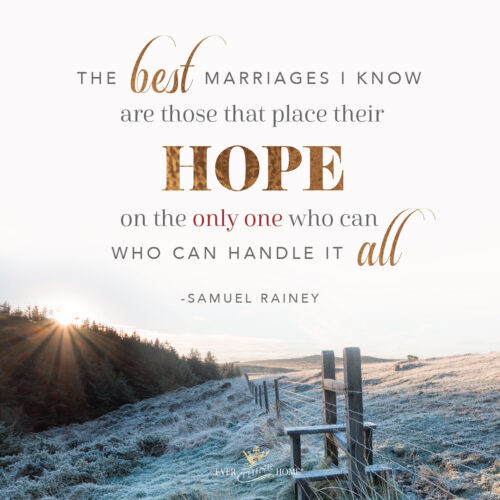
We need hope
As I write this, it is the middle of December. It’s the church season of advent. I love the four weeks of advent because it is the closest experience of hope that I have all year. Yes, Christmas morning is great with presents, surprises, and joyful kids (mostly). But that is just a small part of the hope that comes from this season.
We hope (wait) expectantly for Christmas morning. To celebrate Jesus’ birth, and to anticipate His second coming. Hope without this sense of anticipation of what truly is to come is nothing more than a cheap fantasy that we can have all our desires met here on earth.
You might feel hopeless in marriage because you’re not really engaged with hope.
When Stephanie disappoints, hurts, or offends me, it is a reminder that she is not my savior. Whether she knows it consciously or not, she often reminds me of my need for a savior. And to be honest, I don’t respond well very often. I feel anger and resentment when she gets in my way and doesn’t fulfill all of my needs. One of the best gifts I can give to her is to not punish, retaliate, or rule over her when she hurts or disappoints me.
Over more than 20 years of marriage, one of the most comforting experiences of my life is the two of us waking up day after day aimed at doing better than the day before. But it wasn’t always that way. We’ve had to fight hard to develop that kind of relationship. We’ve done a lot of work together, and there is still more to do.
Relationships need attention
When I am at work, I often hear, “I just want to be happy and live in peace” when asking people what they desire in their marriages. Generally this is a reaction to the growing disconnect and conflict that exists between husband and wife. However, when you don’t do both maintenance and repair work on the relationship, it will decay and break down. This is a truth of the material world as much as it is for relationship the relational world. Relationships don’t survive without attention.
Cleaning up and fixing something that has been neglected for a long time takes more energy and effort than the time it would have taken to maintain it. In relationships, if you do not spend the time proactively working and engaging the faulty issues in your marriage, when it comes time to “fix it” it’s going to feel overwhelming. Perhaps even hopeless.
This overwhelming feeling, coupled with the everyday needs and demands of life, make it even more difficult to find the courage, energy, and hope to dig out of the mess. If you’re at this place of hopelessness in your marriage, consider these questions as a starting place to begin the repair:
Who is the subject of your hope?What are you waiting for?How are you handling the tension of your hopeful waiting?How can you help serve the hopelessness your spouse might be feeling?
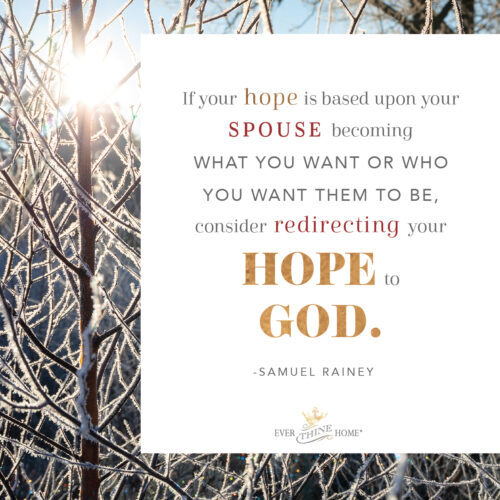
Bringing hope back
If your hope is based upon your spouse becoming what you want or who you want them to be, consider redirecting your hope to God. Marriage counseling with a professional can be a great way to explore the specific repairs that your relationship needs. If you’re unable to meet with someone, consider these suggestions as a place to begin.
Ready to get started bringing hope back into your marriage?:
Do go on regular dates with your spouse.Do monthly budget meetings to review and plan financial concerns and needs.Do yearly/bi-yearly marriage enrichment activities (counseling, retreats, etc.).Do something together that you are both passionate about.Do tell your spouse what you like, love, and admire about them.Do keep your screens (television, phone, computer, tablet) turned off at least two nights per week after 8 p.m.Do practice non-sexual touch without it leading to sex.Do not blame your spouse for anything, ever. Own your actions. Let God deal with your spouse’s actions.Do not use the word “divorce” unless you are filing.Do not let your life become consumed with work, alcohol, social media, video games, food, or the TV.Do not hide behind your kids’ activities to avoid conflict.Do not use your kids to fulfill your loneliness.Reflections from Psalm 40
While these suggestions are all key principles for a healthy marriage, they won’t matter much if your hope is not in its proper place.
I have been reading Psalm 40 quite a lot over the last six months as I engage in my own process of waiting. Lately I’ve been reading it by half-verse. It’s made me wonder how long this process of waiting and response took for David. I’m guessing a lot longer than he wanted, and a lot shorter than it could have been! In closing, here are some reflections and wonderings for you about this passage on hoping and waiting for God:
Psalm 40:1a: “I waited patiently for the Lord”
Just sit with this part of the verse for a moment. Wait with this verse. David waited patiently. With hope. With anticipation. With faith that God would indeed come. And he does. And I wonder: What are you waiting patiently for?
Psalm 40:1b: “He turned to me and heard my cry.”
God turned towards David and heard his plea for help. The first act from God is to hear. To turn towards. At this point, David is probably still waiting patiently for something to be done even though God has already done something by turning towards David and hearing him. And I wonder: How have you missed God turning towards you and hearing your cry of help?
Psalm 40:2a: “He lifted me out of the slimy pit, out of the mud and mire”
God acted again, probably beyond what David hoped for. He lifted David out of the mess, but the mess was still there. And I wonder: What mess is God lifting you out of that you need to clean up?
Psalm 40:2b: “he set my feet on a rock and gave me a firm place to stand.”
God has now acted three distinct ways in response to David’s plea for help. He gave David stability on the rock when he had none for himself. This firm place gave David the ability to not worry about where he was standing so that he could attend to more important matters. And I wonder: What rock has God set your feet on?
Psalm 40:3a: “He put a new song in my mouth, a hymn of praise to our God.”
In this fourth act from God (4!) we see the focus change from God and David to David and his relationship with his community, his people. A hymn of praise to our God suggests that others will benefit and join in with David. And I wonder: Who needs to hear the new song God has given you and what you’ve been waiting for?
Psalm 40:3b: “Many will see and fear the Lord and put their trust in Him.”
A new song of praise for what God has done in David’s life will turn the hearts of many towards God. David had to ask, wait patiently, let God do the work only God could do, and then go and tell others about this work. The result? More people with more new songs to sing. And I wonder: Who around you is singing new songs to point you towards faith in and fear of God?
In the end, I believe we will all have to answer a question like this from God: “How was it for you hoping and waiting for me?”
With your request, God’s help, and your faithfulness to respond, no relationship is beyond repair. I have seen couples dealing with multiple layers of betrayal, lies, and brokenness work minor miracles on healing their relationship. On your wedding day, your spouse the right one for you. Don’t buy into the lie that there is someone better out there for you. If you’re willing to do the hard work, your hope can be restored.
The post Does Your Marriage Feel Hopeless? appeared first on Ever Thine Home.
November 20, 2023
13 Great Ideas for Practicing Gratitude During Thanksgiving and Year-Round
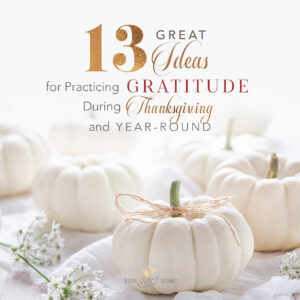
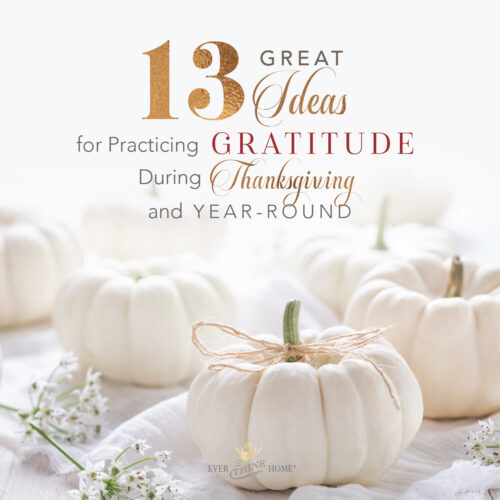
The more I learn about, think about, and practice gratitude, the more I realize it is one of the best ways of demonstrating our faith in God. Thanksgiving week provides an opportunity to teach your children about the value of showing gratitude as a way of life—all year long.
1 Thessalonians 5:18 tells us to “give thanks in all circumstances; for this is the will of God in Christ Jesus.” Gratitude is a mindset to be cultivated and grown. The more you focus on gratitude, the more you truly desire to give thanks in all things, the more it becomes a practiced way of life every day.
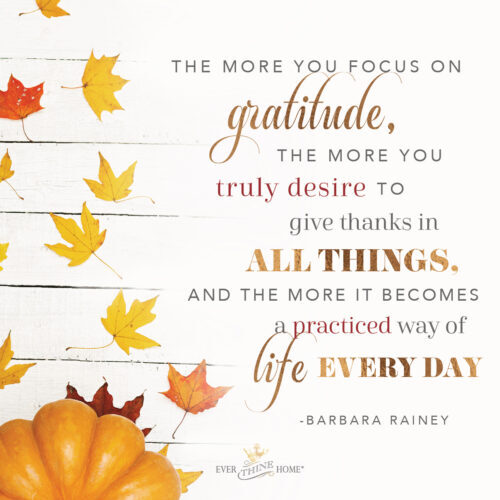
Here are some ideas for helping you and your family cultivate and train your hearts and minds to be more grateful: two new resources from our Etsy store, five Thanksgiving crafts for kids (from my friend Janel Breitenstein), and then six ideas for practicing gratitude every week.
Ready to grow in gratitude this season?
Two new Thanksgiving resources from the Ever Thine Home Etsy store:
I promised my family that I would create a shorter version of my book, Thanksgiving, A Time to Remember, which tells the story of the Pilgrims and the first Thanksgiving. So this year we present a 10-15 minute version that can be downloaded and read on a tablet. You can also print hard copies, which is what I’m doing for our family this year. Reading the story of the Pilgrims every year at Thanksgiving encourages gratitude both for all they sacrificed and for all the benefits we enjoy today. I hope this shorter version makes it easier for your family to add this reading tradition to your Thanksgiving Day every year. You can find the ebook here.2. Another new item in our Etsy store is a template for a “gratitude tree.” This is a really fun way to get your whole family involved in writing down what you are grateful for! The leaf template is easy to print at home and then add to a branch from your yard or a cutout tree from construction paper.
Use this leaf template to create your own gratitude tree! You can cut as many leaves as you want and have each family member write what they are thankful for each day. Punch a hole in the leaves and tie a string on to hang them, or simply use tape or glue to hang each leaf.
These are just two of our Thanksgiving resources in our Etsy store. You can find all of them here.
5 Easy Crafts to Encourage Your Children to Be Grateful on Thanksgiving, b y Janel Breitenstein
Create a paper chain to countdown to Thanksgiving. As the links are removed each day, kids can write something new for which they’re thankful. Keep the slips in a jar and have them read random selections at Thanksgiving dinner.Craft thank-you cards together to send to meaningful people in their lives. Use a 3-D material, like felt or craft foam, to add excitement and sensory interest for younger children. Or use vibrant colors clipped from magazines to form the feathers of a funky turkey on the card front.Create a “Give Thanks” banner and hang it in your home to remind your whole family to give thanks during this season. You could even encourage each family member to write specific things they are grateful for on the back of each letter. Click here for a free download.Use construction paper to cut brightly colored turkey feathers large enough for children to write on. Then, let your children write things for which they’re thankful (help younger children write their thanks), or Bible verses on thankfulness they find from the Psalms. Finally, let them hide the feathers all over the house for a few days of extended gratitude as the feathers are found and read aloud.One harsh winter, early pilgrims had to survive on only five kernels of corn a day! Hand a child five kernels of corn and discuss what this must have been like. Gently explain how easy it is for us all to complain … but simple reminders can encourage us to turn complaining into thanks, trusting God even when it is hard to see good things. Let your child glue the kernels in a row on plain cardstock. If you want, provide a few verses from which they can choose, writing one beneath the kernels. Then frame the dried creation simply and display it in their room.6 Ideas for Practicing Gratitude Throughout the Year
During dinner, every day, see if your family can collectively think of 10 things you are grateful for. Keep a running list or make a new list each night. You’ll be surprised how transformational this practice will be for your family.Type out a few texts, emails or even a handwritten thank-you note to express gratitude to someone who you appreciate and value once a week. This would be good for kids, too, even though they’ll likely complain initially! Or write a thank-you letter or email to someone in your past who had a significant influence in your life. Perhaps a high school coach or teacher, or a small-group leader, or a friend or relative who did something special for you.Read aloud a Psalm of thanksgiving to your family every day before school or during dinner. Here are a few: Psalms 89, 92, 95, 100, and 111. Start the habit of genuinely thanking people who help and serve you throughout the day: the librarian, the cashier, the waitress, the janitor in the restroom, the Sunday School teacher, even airport security agents. And whenever possible, make sure your children see you do it. Dennis started thanking airport security workers a few years ago, and watching him has motivated me to notice the many people in service jobs who are usually overlooked. Thanking them is actually fun! They are often genuinely surprised and smile in return.On the back of an interior door, post a piece of poster board and keep a pen attached with adhesive Velcro. Make it a family goal to fill the poster with drawings of things you are grateful for. Or start a “blessings journal” for yourself and for your family. Make it a goal to write and remember at least one way God blesses you each the day. Even recognizing God in ordinary things like seeing a rainbow or watching your toddler’s admiration for a caterpillar is evidence of God at work.Write a list of circumstances in your life that concern you. Then thank God for each item on the list knowing that you are obeying the command to “Give thanks in all circumstances.”
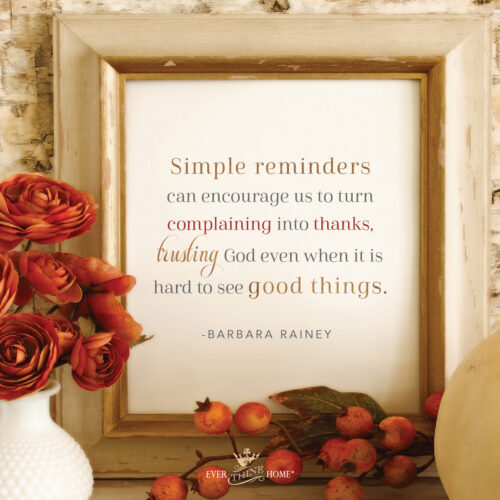
Gratitude is contagious. The more you cultivate it in your life—not only during Thanksgiving week but the remainder of the year as well—the more you’ll see others follow your lead!
The post 13 Great Ideas for Practicing Gratitude During Thanksgiving and Year-Round first appeared on Ever Thine Home.
The post 13 Great Ideas for Practicing Gratitude During Thanksgiving and Year-Round appeared first on Ever Thine Home.
October 30, 2023
Do You Know About All Saints’ Day?


I’ve long had mixed feelings about Halloween. Yes, it’s a fun family time—especially for kids—to dress up in costumes and celebrate the fall. But in our present culture it has also become a strange celebration of horror and death … to the point where sometimes you want to turn your kids’ eyes away from the grisly costumes and decorations.
But in recent years I’ve learned more about the day after Halloween—and that’s a day worthy of our attention and our celebration.
That day is All Saints’ Day. It falls on November 1 and is meant to show gratitude to God for those believers who have gone before us. Though All Saints’ Day is not a public holiday in America, it is in many other countries.
I’d love to see more followers of Christ take advantage of this special day to remember the saints who have influenced our faith.
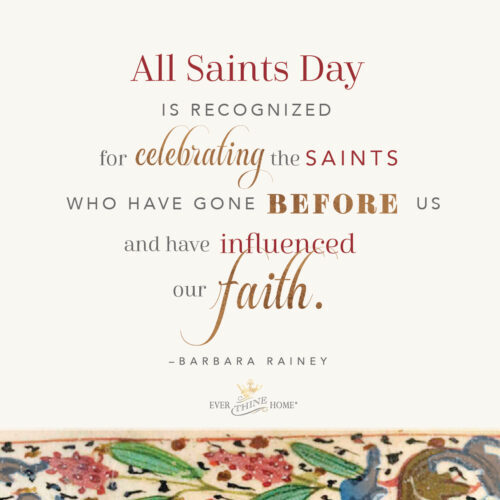
When we hear the word “saint,” many of us may think of people honored by the Catholic church because of their remarkable faith and works. Catholic saints are believed to have performed at least one “miracle” during their ministry.
But the Bible uses the word “saints” to describe Christians in general—those who have been saved by the blood of Christ and set apart for the sake of the gospel. 1 Peter 2:9 provides a good description: “But you are a chosen race, a royal priesthood, a holy nation, a people for his own possession, that you may proclaim the excellencies of him who called you out of darkness into his marvelous light.”
So, all of us who are born again—alive or dead—are “saints.” All Saints Day is an opportunity for saints who are alive to celebrate those saints who have touched our lives … and I think that’s a good tradition.
All Saints’ Day is a great time to tell stories. Who are some of your favorite heroes from the Bible? Who are some saints whose lives have challenged and influenced you?
One of my favorite stories about a saint who lived long ago and influenced many people is about a young teenager named, Tarore (tah’-rah-reh), who lived among the Maori people in New Zealand. In 1835 the first missionaries arrived in New Zealand. Among them were Alfred and Charlotte Brown who left their homes and family to take the story of Jesus to people who had never heard. Soon after their arrival they began a mission school to teach the Maori children to read and write in their own language. One of the first students was Tarore the daughter of Ngakuku (nah-ku-kuh), a relative of a famous chief. She was a very bright student who quickly learned to read.
Tarore’s missionary friends gave her a copy of the Gospel of Luke. Tarore treasured her book and carried it safely around her neck in a straw purse. When she returned to her tribe every evening from school, she read the stories of Jesus to anyone who would listen. With fatherly pride, Ngakuku listened to his little girl reading and soon he believed that Jesus’ way to live was better than the rules of his tribe. He gave his life to Christ to follow His way forever.
But times were troubled in the land of the Maori. Fighting was an ongoing way of life among the tribes. The Browns realized they needed to move the mission school to a safer location, and some Maori children were allowed to go with them to continue their schooling. Led by Tarore’s father, the missionaries and the children caravanned to the new location, camping along the way at night.
One evening, their cooking fires attracted the attention of a neighboring tribe. Later, when all were sleeping, warriors crept toward them intending to kill the entire group.
But when a dog barked out a warning, everyone fled into the forest. All except 12-year-old Tarore, who did not hear the barking. She alone was killed by the warriors. One of them found her little book, the Gospel of Luke, in the purse she always carried, and though he had no idea what it was, he took it.
When Ngakuku found his daughter’s body, he was overwhelmed with grief. Before he found Jesus he would have demanded “utu”—the payment of a life for a life. This law of revenge was part of the Maori tradition. Yet in his sadness he remembered the words Tarore read from Jesus: “Love your enemies” (Matthew 5:44) and “Forgive and you will be forgiven” (Matthew 6:14).
Now Ngakuku knew revenge was not the way. He resisted his desire to seek retribution against the man who killed his daughter, for the higher call to love his enemies.
Meanwhile, the warrior who stole the little book was curious about its contents, so he found someone who taught him what it said. As he listened, he too believed the words of Jesus and felt great regret that he had helped kill Tarore.
He decided to ask for forgiveness. Walking a great distance and taking a great risk that he might be killed in revenge, this warrior found both Tarore’s father and the forgiveness he needed. Their story, along with other copies of the Bible, spread among the tribes leading many to choose the way of peace that Jesus taught. Even the greatest of their chiefs became a Christian and built a church for his people.
Today, in New Zealand over 175 years later, descendants of both the Maori tribes and the white settlers learn the story of Tarore in school. They learn that it was missionaries who brought Christianity to the native people, but it was the people themselves who shared the way of forgiveness with one another.
Stories about saints like Tarore enrich our walk with Christ and challenge us to walk in obedience to God’s Word. You can probably think of saints who have influenced your life; how about telling their stories to your family?
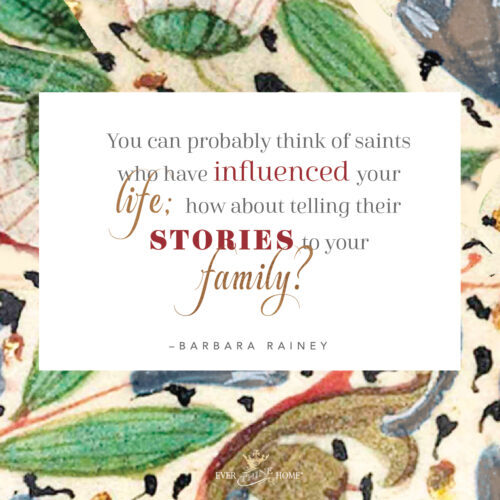
When I think of saints who have influenced me, I could talk about two women, Sally and Pam, who led me to Christ and helped me grow in my faith as a university student over 50 years ago.
I could talk about Bill and Vonette Bright, who founded Campus Crusade for Christ (now called Cru), the organization I’ve worked with ever since I graduated from college. And I could go back even further and talk about Henrietta Mears, the remarkable woman who showed Bill how to walk with Christ when he was a young man and then led his fiancée, Vonette, to the Lord. When I look back on my spiritual heritage, I can see a straight line from Henrietta Mears to Bill and Vonette Bright to Sally and Pam and me … and then on to anyone God has used me to influence over the last few decades.
I encourage you to use All Saints’ Day to broaden your knowledge of the saints who have come before us and then to tell stories to others. These stories are part of us because we are all part of the Body of Christ. One of my favorite hymns, “Crown Him Lord of All,” ends with this stanza:
O that with yonder sacred throng
We at His feet may fall.
We’ll join the everlasting song
And crown Him Lord of all.
I look forward to the day when I will fall at the feet of Jesus and join the blessed saints of old in that “everlasting song” of praise to Him. What a day that will be!
To help you celebrate All Saints’ Day, our team here at Ever Thine Home has created some cards for you to print at home . There are five saints included in the set of cards along with some blank cards on which you can glue a photo and write the name of one or more saints who have been influential in your walk with Christ. You could pass the cards out to your family during dinner, read the short description of each, and then talk about other saints who have influenced each of you.

If you enjoyed the story of Tarore, you can read more about her and several other saints in a short book called Tales of the Resistance . It’s a collection of stories about heroes of the faith who were able to resist sin and overcome circumstances to help share the good news of Jesus with others. We have a limited number of these books left and would love to get a copy into your hands. You can order both resources through our Etsy store .

The post Do You Know About All Saints’ Day? first appeared on Ever Thine Home.
The post Do You Know About All Saints’ Day? appeared first on Ever Thine Home.
October 16, 2023
3 Steps to New Purpose When Your Kids Leave the Nest
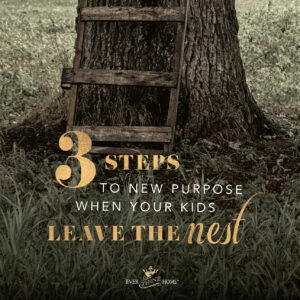
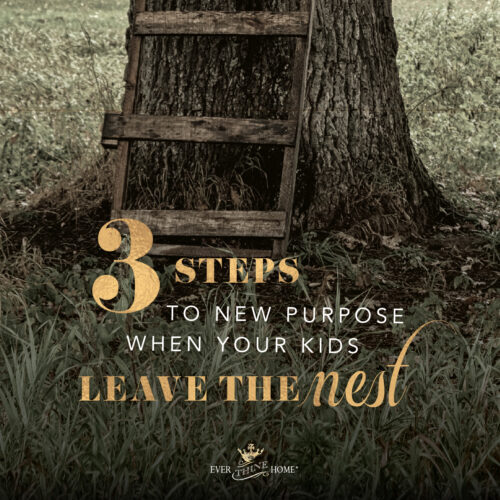
Tears streamed down Sarah’s face as she began to describe how she was feeling, “Our last child, Emily, has just left for college and I find myself crying almost every day. For 30 years I’ve poured my life into my kids. Even though I started two of my own companies and was very successful, my kids were always my priority. Now nobody really needs me. I feel like I’ve been fired. I am so lonely.”
Loneliness can catch us unaware. Georgie experienced it in the auto repair shop. As she was standing in line at the checkout counter, a song started playing over the intercom. It was one of her son’s favorites. In fact, his band had played it, and just hearing it brought back memories of all the nights of band practice in their basement.
To the astonishment of the clerk, Georgie burst into tears. Her son had only been gone two months and her heart was still tender.
Nancy felt the loneliness most at the dinner table. Her husband and daughter used to joke around and mealtimes were full of laughter. Now, conversation between her and her husband seemed forced, even boring. The cloud of loneliness was thick. And it wasn’t much fun to cook anymore.
Julia, a single parent, has raised her kids alone. Her daughter is a senior, and as they look at colleges, Julia wonders what the empty nest will be like for her. “One thing I’m realizing is that being a single parent has some hidden blessings,” she says. “I know I will experience loneliness in a fresh way when Liz leaves, but I am comfortable with being by myself. Feeling lonely because I miss my child is different from being miserable and being alone. And I’ve learned that if I’m too lonely, it’s my own fault. I need to reach out to someone else.”
At some level, each of us experiences loneliness during our years as a mother. And when our children leave home, the adjusting to the loneliness of the empty nest can be an especially difficult task.
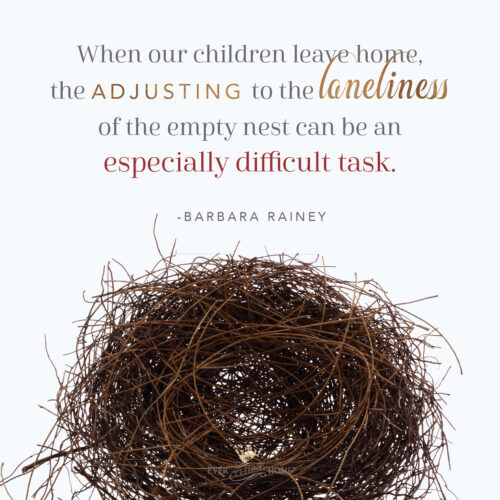
Three adjustments will help ease the pain of loneliness and give us a fresh perspective on what can become a grand adventure:
1. Recognize the “Season Principle.”
Over the years both of us have found it helpful to recognize that we go through different seasons in life. There’s the season of being single, of being a newlywed, of raising young children, and of parenting teens. And the empty nest season. And finally there are the golden years at the twilight of life.
Seasons aren’t purely biological; interspersed through life are seasons of loss, seasons of pain, seasons of stress, seasons of joy. It’s helpful to look at life in terms of seasons. Every season will have unique challenges and each season will have unique blessings. We all remember the challenges of the infant years: sleep deprivation and a lack of appreciation. It’s a rare four-year-old who says, “Mommy you are doing such a good job of raising me. Thank you!”
But those years also hold unique blessings. I (Susan) remember when Libby saw the ocean for the first time. As her little eyes grew wide with fright and amazement, she exclaimed, “Mommy, it’s too full. You need to let some of it out!”
It’s helpful to articulate the challenges and then choose to focus on the blessings of each distinct season. When we define the challenges and discuss them with others, we discover that we are normal! When we are intentional in looking for the blessings, we discover the joys that God has prepared for us. It’s important to remember that no season lasts forever. We want to really live in each unique time, and miss nothing.
So what about the season of the empty nest? We are already discovering some of the common challenges—that’s one of the purposes of this book. But we don’t want to remain stuck in the challenges. Instead, we want to focus on the benefits of this season. Yet, no matter what our current challenge is, the place to begin is with God.
2. Run to God.
At different times every one of us will get stuck. We’ll feel blue, we’ll experience loneliness, we’ll be anxious about the future. It isn’t just being in the empty nest; it’s being in transition. Moving from one season to another is uncomfortable and awkward. In fact, as much as we’d like to think stability is the norm in life, actually we spend more time in transition.
Where do we go in a time of transition? The book of Proverbs has a piece of advice for us: “The name of the Lord is a strong tower, the righteous run to it and are safe” (18:10).
Our inclination can be to run to our husbands, our mothers, even friends. We might try to hold onto our children in an unhealthy way—unhealthy for them and for us. Or our tendency can be to wallow in our loneliness. While others can be helpful, ultimately it is God alone who will offer comfort and help us move forward.
3. Find some friends.
A few years ago the two of us were attending a conference in Florida. When we finally had free time, we took a long walk on the beach with our friend Mary. As we walked, we began to ask each other, “What has been going on in your life? Is there a theme of the past year? What have you been thinking, learning, or struggling with?”
All three of us were in different phases of the empty nest. We were all busy with lots of acquaintances in our lives. Yet at the core, each of us felt lonely. We realized that what we longed for was to reconnect with some other women. In a way we felt we’d put deep female friendships on hold for several years as we focused on our kids.
It was now time to move out of that isolation and into community.
Joy had a similar experience. A mother of four and a well-known speaker, she had a meltdown when her last child left. She felt like her identity had just walked out the door. Even though she and her husband were unusually close, she knew he couldn’t really relate to how she was feeling. She needed some other women; they would understand.
Joy decided to be proactive. She called up 13 women she’d known off and on over the years, and together they went away for a weekend. Simply being able to share honestly what was going on in her life and listening to other women made her feel “not so stupid.” And it actually helped her feel normal again.
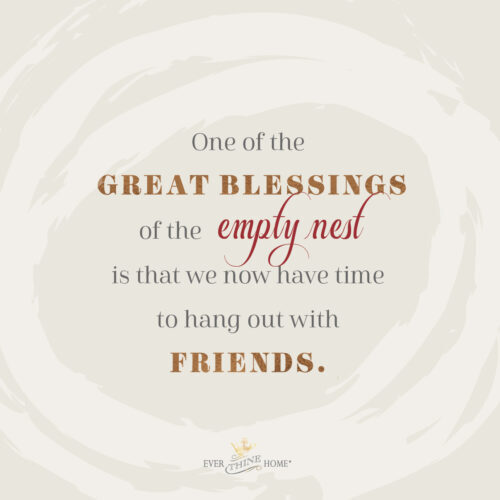
One of the great blessings of the empty nest is that we now have time to hang out with friends. If we are out of practice, it may be awkward at first, but take the plunge. There are rich relationships out there for you, and the joy that is waiting for you in “girl time” is amazing.
We’ve found it to be one of the best cures for loneliness.
Excerpted from Barbara and Susan’s Guide to the Empty Nest © by Barbara Rainey and Susan Yates. Used by permission of FamilyLife Publishing.
The post 3 Steps to New Purpose When Your Kids Leave the Nest first appeared on Ever Thine Home.
The post 3 Steps to New Purpose When Your Kids Leave the Nest appeared first on Ever Thine Home.
September 11, 2023
Six Tools to Rebuild Trust in Marriage
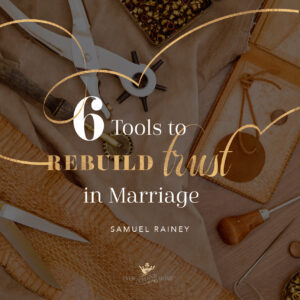
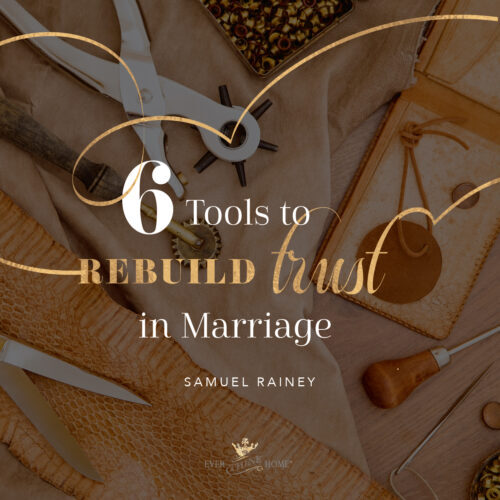
A Note from me:
When my son Samuel shared this six-part series with our team, there was some vying for which website would run it first, Ever Thine Home or The Raineys. As you can see, Ever Thine Home won our little team debate!
I am so happy to share Samuel’s first marriage tool with all of you. Samuel does a great job laying out common issues most marriages face and some very practical ways to deal with them over the rest of this week. I also want to encourage you and your friends to subscribe to Barbara’s Friends and Family so you can read all six! Plus all my new content slated for this fall.
Remember you can always enjoy a free week trial to get a chance to read all six tools plus check out everything I’ve done this year for Barbara’s Friends and Family .
Introduction
I’ve broken many bones in my body, but there was a stretch of three consecutive years when I broke an arm. If you’ve ever broken a bone you know that the healing process is neither fun nor fast. It’s painful, it takes time, and it usually requires the help of others. Yet when the healing is done well, the place where the break occurred will usually become the strongest part of the bone.
The problem with an incorrect healing process is that when the bone heals without an external aid, it ends up healing incorrectly. This is why my left pointer finger is crooked: I didn’t seek help when I broke it while wrestling with my boys over 15 years ago.
Like the bones in our body, a relationship cannot stand without the bones of trust. Unfortunately these bones get broken, just like those in our body. It’s painful when breaks occur in a relationship. Sometimes the healing process feels more painful than the break itself.
Most relationship issues I encounter in my counseling office are a result of broken trust. Stories like infidelity, workaholism, addictions, lying, gambling, and many other life changing situations. How we handle money is another common story of broken trust, and that’s why Rashad and Susanna called me.
They sat down on opposite ends of the couch, turned off their phones, and stared at me. After a moment of waiting to see if either of them would talk about why they were here, I asked how I could be of help. Susanna quickly took the opportunity to speak and over the next few minutes described the ups and downs of their 13-year marriage. She described how great they do together when they’re on vacation or away from the everyday stressors of their three kids and two dogs.
All of what she was saying sounded like pretty common marriage challenges, but I had a sense that there was something bigger concerning them. She finished her recap and looked at Rashad. He sharply asked her if that was all that she was going to share. Looking somewhat defeated, she said that he could share the rest.
“She’s a shopaholic, and has been lying to me about money for years,” he said. “We’ve been dealing with this issue for our entire marriage. She keeps promising she’ll stop, and just last week I found another credit card with over $11,000 of charges. I just can’t trust her anymore.”
Over the years, Rashad and Susanna had met several times with their pastor on this issue. But the problem persisted. Rashad would say, “How can I trust her if she keeps doing it?” To which she would respond, “I promise that I won’t do it again!”
One of the most beautiful, yet difficult, realities as followers of Jesus is that we are called to forgive others. Ephesians 4:32 says this, “Be kind and compassionate to one another, forgiving each other, just as in Christ God forgave you” (NIV).
Forgiveness is really hard to give when the behaviors of the other person don’t seem to be changing. Rashad and Susanna kept showing up week after week, and after almost a year of working together they were able to reconcile in a way that neither of them had experienced before. From my seat, there were two reasons they had this new experience of forgiveness.
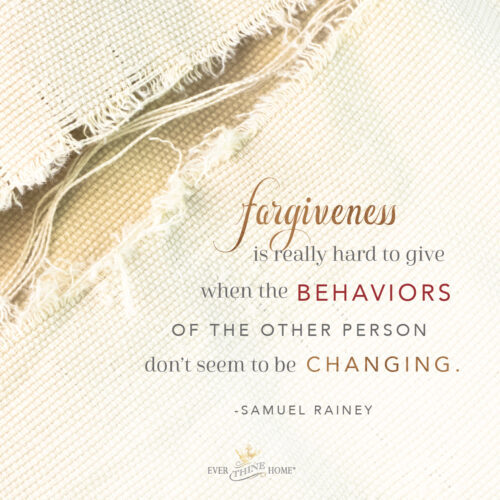
First, early on it became clear that Susanna’s way of coping with painful and stressful challenges in life was to shop. She realized that her shopping addiction started in college when her parents divorced and then declared bankruptcy. Identifying this helped Rashad to see that her lying and spending was not about her being a malicious person; she was reacting to a lot of pain. He found compassion for her, which helped to quiet his feelings of anger and resentment.
Second, Susanna worked really, really hard at following the plan we developed for rebuilding his trust. She didn’t do it perfectly. Yet over time she grew more able to get back on the plan. Rashad began to trust her more each day because he saw that she was truly putting in the work we had all agreed upon.
I heard a biblical scholar talk about how the Psalms follow a repetitive structure and process. There are Psalms of orientation, dis-orientation, and re-orientation. When tragedy happens in life, we get disoriented. Rebuilding trust in relationships is the process of reorientation. Discovering a new way to relate. So many people get caught up in trying to “get back to the way it used to be” thereby missing the opportunity to heal what’s been broken.
I’ve found that there are six specific tools that you need to rebuild trust. These tools can be done without the participation of the other person, they can be used on their own, or in the specific order I am going to lay them out.
The tools:
· Own your mistakes.
· Tell the truth.
· Delay gratification.
· Make amends.
· Follow through.
· Use your powers for good.
Each of these six tools are great to practice on their own. And you’ll probably experience growth in doing so. But combining all six together is like a trust-building super-tool. I’ve yet to see anyone utilize this super-tool and not find tremendous benefit in their life. When couples do this process together, it’s pretty amazing to see the transformation in their relationship.
Tool #1: Own Your Mistakes
“Why do you see the speck that is in your brother’s eye, but do not notice the log that is in your own eye? Or how can you say to your brother, ‘Let me take the speck out of your eye,’
when there is the log in your own eye? You hypocrite, first take the log out of your own eye, and then you will see clearly to take the speck out of your brother’s eye.”
~ Matthew 7:3-5 (NIV)
Owning your mistakes is the foundation upon which all the other tools rely on. It’s like learning how to do math—you first have to know the numbers before you can add and subtract.
Trust requires that you own your mistakes … admit them and take responsibility for them without blame. Without justification. Without explanation. Pure unadulterated ownership will breathe life and hope into a weary relationship.
This makes me wonder what Adam and Eve’s story would have looked like in Genesis chapter 3 had they owned up to their mistakes. After they sinned and ate of the forbidden fruit (verse 6) God finds them in the garden hiding and clothed in fig leaves (verse 9). He first addresses Adam and asks what happened (verse 11). Adam blames God and Eve for his sin, and only owns his mistake when Eve gives him the fruit (verse 12). Then God addresses Eve, and she follows Adam’s lead and blames the serpent for her mistake (verse 13).
I have no idea what God might have done if both of them were repentant and owned up to their sin. As a dad, I know that I still give consequences to my kids when they disobey, but it’s a far different relationship between us when they disobey and then take responsibility for their actions.
Perhaps Adam and Eve would have maintained a closer relationship with God had they not blamed and instead owned up to their actions. Regardless, their sin resulted in exile from the Garden of Eden and a new reality of pain and hardship because of their sin.
Like Adam and Eve, our inclination after a personal failure is to avoid responsibility, blame others, and shift the attention away from ourselves. This natural reaction breaks trust in others because they can’t rely on you to recognize and own the part you played in the failure.
One thing I’ve learned over the past 20 years working with people and their relationships: Everyone has light and darkness in them. This truth has been discussed in the Bible and by the great thinkers of every generation. Author and philosopher Alexander Solzhenitsyn said:
“The line separating good and evil passes not through states, nor between classes, nor between political parties either—but right through every human heart—and through all human hearts.”
The apostle Paul speaks to this truth in Romans 7 when he laments about doing what he hates and not doing what he wants to do (verse 15-20). We live by two laws: the law of the flesh (sin in us), and the law of God (Christ in us).
Owning your mistakes is shining a light on your darkness. This simple but difficult act proclaims that the story of Jesus conquering death and being raised to life is indeed true. That if Jesus came to be a light in the darkness (John 18:12), then it is our honor and privilege to participate with Him in allowing the light into the darkness. On the contrary, refusing to own your mistakes (blame, justification, ignoring, etc.) casts darkness over the light. This is the battle that you, me, and everyone on the planet is fighting.
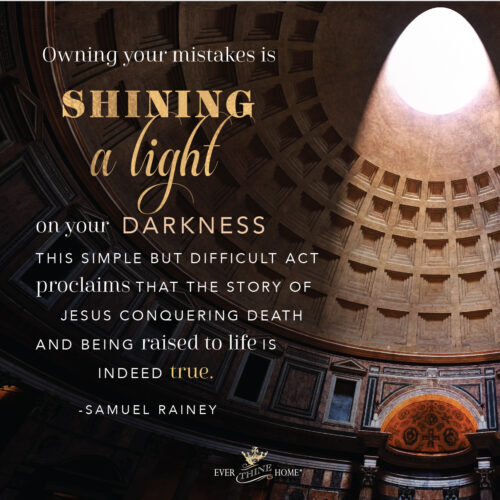
Step into the light. Take full responsibility for your actions as if they happened in a vacuum. For some amount of time, let your mistake be front and center in the relationship so that you can truly understand the impact your actions had on the other person.
Don’t try to explain the reasons for your failure. Don’t blame someone on why your mistake was not really your fault. Lastly, your intentions don’t matter (unless the other person, with curiosity, asks about why you did what you did).
Mastering the use of this tool will build your maturity. The benefit for others is that they will grow in their trust of your responsibility. They will know that you can and will handle the difficulties life brings your way. And when you mess up, they will trust you to own up to what you did. The cool benefit of this is that when you show yourself to be responsible as your primary action, grace and mercy are plentiful when mistakes happen.
Owning your mistakes …
Builds in you: Maturity
Helps others trust in your: Responsibility
Samuel Rainey, son of Barbara and Dennis Rainey, is a marriage and family therapist. He and his wife Stephanie have four kids.
The post Six Tools to Rebuild Trust in Marriage first appeared on Ever Thine Home.
The post Six Tools to Rebuild Trust in Marriage appeared first on Ever Thine Home.
Barbara Rainey's Blog
- Barbara Rainey's profile
- 24 followers







